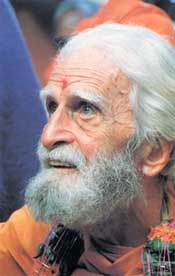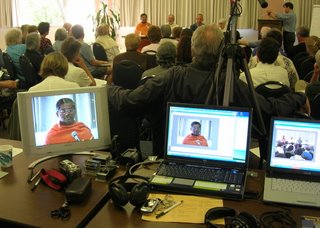
Fr. Bede is known for his journey to India in the 1950s to find "the other half of my soul," and for the "marriage of east and west" he articulated in his many writings and the talks and conferences he gave around the world. In 1968 Fr. Bede was asked to take over Saccidananda Ashram, popularly known as Shantivanam ("Forest of Peace"), in Tamil Nadu, and there, clad in the orange colored cloth of a sannyasi, he gathered around him disciples from all over the world. Since his death, the ashram has continued to draw pilgrims from diverse religious traditions who want to experience the spirituality of India from a Christian perspective.
Fr. Bede was one of the outstanding religious leaders of the 20th century. The Dalai Lama credits him with "opening the hearts and minds of mankind to gain understanding and acceptance of all the major religions." C.S. Lewis, with whom he studied at Oxford, dedicated his autobiography to him. Cardinal Basil Hume called him "a mystic in touch with absolute love and beauty." In his writings, Bede attempted to harmonize Eastern mysticism and Western science with Christianity. In his person, Bede exemplified presence and generosity. He was a priest, guru, prophet, teacher, swami and friend to all he met on the path.
The first two conferences, organized by Fr. Joseph Wong, assistant to the Camaldolese Prior General, Dom Bernardino Cozzarini, were held in California, and the next three will take place in England (this month), at Camaldoli in Italy (November), and at finally at Shantivanam on the centennial of his 100th birthday, December 17.
The first gathering, an invitational affair for monks and academics, was held at New Camaldoli Hermitage in Big Sur a week ago. They were welcomed by Dom Bernardino from Italy and Hermitage Prior Raniero Hoffman. Father George Nelliyanil, prior of Shantivanam, was on hand, visiting the U.S. for the first time, to present a paper by Brother John Martin, the ashram's resident teacher. Invited to read papers from the academic world, where scholarship into Bede's thought is generating numerous dissertations, were Jesuit Francis Clooney from Harvard, Brad Malkovsky from Notre Dame, Joseph Prabhu from California State University at Los Angeles, and Michael von Brück, theologian and Zen teacher, from Ludwig Maximilians University
 (front l-r, Clooney, von Brück, Prabhu, Coff, Malkovsky, Corcoran, Matus, Freeman; back l-r, Hoffman, Barnhart, Hale, Consiglio, Cozzarini, Wong, Nelliyanil).
(front l-r, Clooney, von Brück, Prabhu, Coff, Malkovsky, Corcoran, Matus, Freeman; back l-r, Hoffman, Barnhart, Hale, Consiglio, Cozzarini, Wong, Nelliyanil).in Munich, Germany. Monastics also presenting papers included Fr. Bruno Barnhart, Fr. Thomas Matus, Fr. Robert Hale, all from Big Sur; Sr. Donald Corcoran, prioress of Transfiguration Monastery in New York state, and Fr. Joseph Wong. Presenting a paper by video was theologian Beatrice Bruteau. On hand to discussion their experiences with Fr. Bede were Sr. Pascaline Coff, founder of Osage Monastery in Oklahoma, the "Shantivanam of the West," Fr. Cyprian Consiglio and Fr. Laurence Freeman, director of the World Community for Christian Meditation.
The two California conferences, both entitled "Carrying Forward the Contemplative and Proaphetic Vision of Bede Griffiths," were sponsored by the Camaldolese Institute for East-West Dialogue. The second gathering for the public was held over last weekend at Mercy Center in Burlingame before a crowd of nearly a hundred people (300 more were on a waiting list unable to get in). Papers were presented by Wong, Matus, Hale, Corcoran and Barnhart, and a round table discussion, chaired by Fr. Cyprian (who led Sanskrit chants before each
 presentation), featured Dom Bernardino, Sr. Pascaline and Fr. George with stories about their personal experiences with Fr. Bede.
presentation), featured Dom Bernardino, Sr. Pascaline and Fr. George with stories about their personal experiences with Fr. Bede.The scholarly papers and the discussions about Bede and his significance were a bit overwhelming. It will take awhile to sort out all the ideas. Clearly, he was a man for all seasons and paths to the mystery that many call God. I missed my one chance to meet him when he visited a bookstore in Santa Cruz in 1992. But I've been to Shantivanam twice, meditated in his hut and sat by his tomb. I find the writings of his predecessor at Shantivanam, Fr. Henri le Saux (also called Abhishiktananda), more congenial. Abhishiktananda agonized over his attempt to integrate Hinduism and Christianity, whereas Bede often seemed to paper over differences with optimistic obfuscation. Several of the academic speakers pointed out that Bede romanticized Hinduism and focused on the intellectual and mystical Vedanta tradition while largely ignoring (perhaps because it frightened him) the popular religiosity of temple worship. While he was a strong critic of the institutional church, and a supporter of equality and rights for women and gays, Bede was in many respects and orthodox Christian. The Christ event, whether historical or cosmic, was at the center of his faith. He advocated a "Christian advaita," making use of the Sanskrit term for non-duality, the mystical oneness at the heart of the revelation of the Upanishads. But, as several speakers pointed out, at the heart of the Christian revelation is love, and love is not possible without two separate identities." Only Jesus can say "I and the father are one"; we are sons of the father by adoption, not by birth.
Because Fr. Bede was first and foremost a Christian, I do not see him as an important figure for inter-religious dialogue, as Fr. Robert Hale argued in his paper.
 Theologian Karl Rahner used the term "anonymous Christ" to locate the Christian revelation within other religions, and Bede followed this practice. But this can border on arrogance and be a stumbling block to true dialogue (in which surprise is always a possibility) with followers of other faiths. Bede's importance, I believe, is for Christians who stumble against the antiquated and reified language of a 2,000-year-old Gospel tradition, a language articulated in a very different cultural context from today. Bede, and Thomas Merton before him, have recaptured mystical insights from both medieval Europe and the Indian subcontinent and made them live again, in Bede's case with the assistance of new scientific and philosophical thinking from Sheldrake, Capra and Wilber, among others.
Theologian Karl Rahner used the term "anonymous Christ" to locate the Christian revelation within other religions, and Bede followed this practice. But this can border on arrogance and be a stumbling block to true dialogue (in which surprise is always a possibility) with followers of other faiths. Bede's importance, I believe, is for Christians who stumble against the antiquated and reified language of a 2,000-year-old Gospel tradition, a language articulated in a very different cultural context from today. Bede, and Thomas Merton before him, have recaptured mystical insights from both medieval Europe and the Indian subcontinent and made them live again, in Bede's case with the assistance of new scientific and philosophical thinking from Sheldrake, Capra and Wilber, among others.Perhaps Bede's most radical ideas concerned the reform of monasticism. Although a priest, he felt that the monk should be a lay person. And although most of his adult life was spent in a monastery or ashram, he felt that the future of monasticism would be in the world. In his last book, The New Creation in Christ: Christian Meditation and Community, Bede wrote that
Some monks may live in monasteries, but increasingly the majority will live in their own homes or form small communities -- a monastic order in the world.To that end, Bede traveled widely in his later years with Sr. Pascaline, Russill and Asha Paul, and Brother Wayne Teasdale (who died earlier this year) in search of somewhere to settle in such a community outside the cloister walls. While that search did not result in the establishment of a lay monastic order, there are numerous experiments going on in that direction at present, including the Sangha Shantivanam in Santa Cruz.
Father Bede Griffiths continues to exemplify the possible of a radical holiness in a radical and secular world.

No comments:
Post a Comment